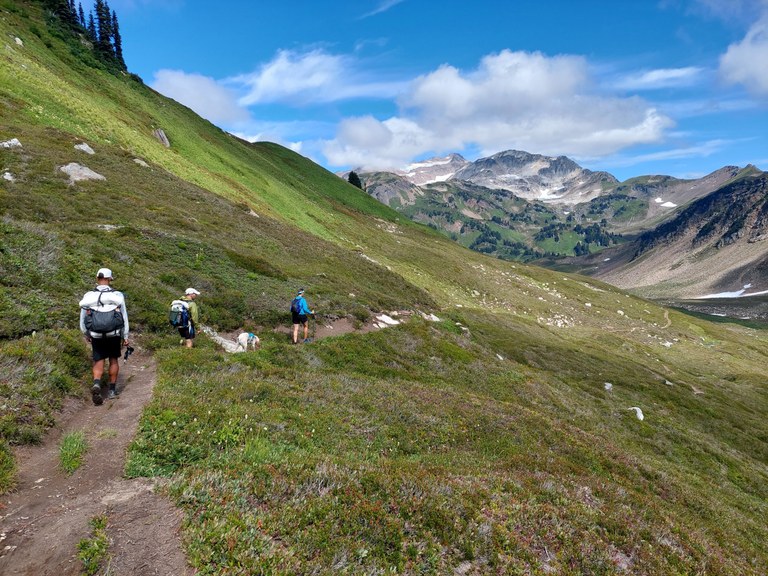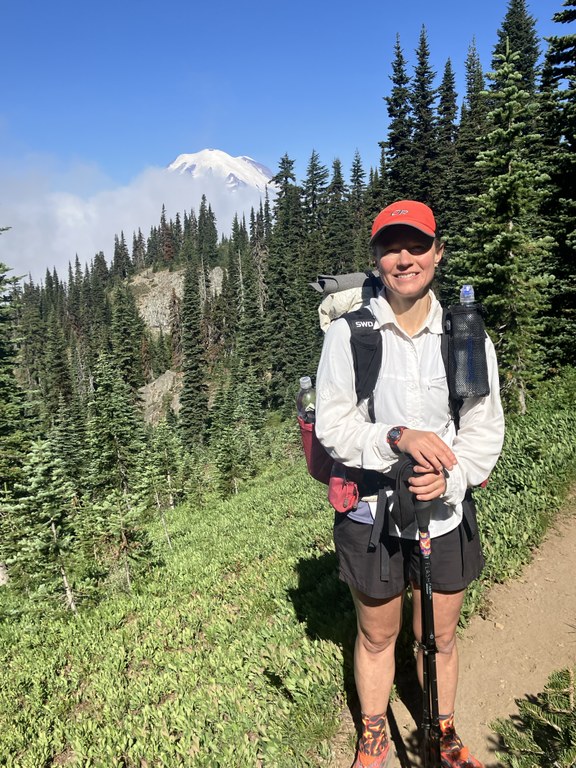 Washington Trails
Association
Washington Trails
Association
Trails for everyone, forever
The landscape of Washington state is changing. As the state’s population grows, along with the demand for trails, hikers have a major role to play. As people who love time outside, we gain so much from trails. The future of trails is in our hands and we have a great responsibility to care for them and each other as we enjoy outdoor spaces. By Andrea Imler, WTA advocacy director
The heat was oppressive — so hot that I could see heat waves shimmering above the ground. Sitting next to a craggy boulder in a patch of shade, I drank some water and ate a snack. I was high up on the flanks of Old Snowy Mountain in the Goat Rocks Wilderness. A warm breeze whipped around me and all was quiet. I felt so alone, but then I heard a happy chorus of voices coming closer. There was laughter, and then I saw the group making their way toward me.
Given the terrain, I saw them before they saw me. I marveled that they seemed so carefree and full of excitement, while I was questioning my choice to be hiking in such heat. And then they were in front of me.
I asked them if they were enjoying their trip and they clearly were. They were from a high school in Seattle and had just summited Old Snowy. It was a first backpacking trip and first peak scramble for most of them. They were disappointed that they hadn’t seen a mountain goat yet.

Views from the Goat Rocks are spectacular. Hikers travel statewide to experience them. Photo by Andrea Imler
The group continued on, and I was once again on my own, deciding if I should continue upward. Inspired by that group, I decided to. I wanted that same joy!
Up higher, a bit of movement caught my eye — three mountain goats were frolicking on a patch of snow a couple hundred feet below me. I wished the school group could have seen them.
Last summer, I took a sabbatical from my work at Washington Trails Association. I spent much of that time exploring some of the most beautiful places in our state via the Pacific Crest Trail (PCT). I met a lot of people along the way, including the high schoolers. The common thread among everyone I met — whether PCT thru-hikers, day hikers, trail runners or first-time backpackers — was how happy they were to be out in nature.
I backpack because that is when I am most connected to the natural world around me. To put it plainly, I feel better when I’m outside. I love the quiet mornings sipping coffee as the sun rises above the ridge. I love the simplicity of carrying everything I need on my back and using my feet to propel me forward. I am grateful for Washington’s spectacular alpine peaks, subalpine meadows, aquamarine lakes and deep forests. I also feel a great sense of responsibility. I have spent the majority of my career working to protect and steward these wild places. I want to ensure that people in the future still have access to them — so they, too, can enjoy watching goats be silly.
I have seen public lands face increasing challenges over time. Our state’s population continues to grow. By 2050, it’s estimated that an additional 2 million people will live in Washington, which means more houses and infrastructure will be needed to support that growth, encroaching on public lands. More people are visiting the outdoors, which we can’t build more of. Climate change is bringing an increasing frequency and intensity of wildfires and more frequent flooding, making some trails and areas inaccessible. Meanwhile, government land managers have dwindling financial resources to meet these challenges and demands.
All of this has a big impact on hikers and public lands. More people are outside on a fewer number of underfunded trails. More people means more of other things too — think full parking lots, dog poop bags left behind and social trails developing around lakeshores and in other delicate areas. And there are impacts we may not see — like how our growing numbers affect sensitive wildlife and wildlife habitat.
Yet I have also seen people step up for trails in so many ways, including volunteering, advocating for funding and land protections, helping more people discover the much-needed benefits of time in nature and picking up litter on every hike. The hiking community is a powerful force for good. We must continue to hone this ethic by giving people the tools they need to be respectful stewards.

Steps today will help protect the trails of tomorrow, like the PCT through Glacier Peak Wilderness. Photo by Andrea Imler
As we embrace this new reality where there are more people and more challenges to the spaces where people love to get outside, we must re-examine how we balance the values of recreation, conservation and access to public lands to protect the core human need for time in nature, while ensuring that these places exist into perpetuity.
We must also recognize that Indigenous people have lived on and stewarded these same lands since time immemorial and maintain their sovereign and inherent tribal rights, including rights reserved by treaties. As some of the least disturbed landscapes, these lands are critical to tribes in protecting the fish, plants, wildlife and sacred places on which their cultures depend. As we re-examine how we weigh recreation, conservation, equity and access to public lands, we must all commit to learning and acknowledging that we are visitors and that our actions impact the abilities of tribes to exercise these rights and care for their ancestral lands.
WTA is committed to creating a sustainable trail system that minimizes the impacts of visitors on the environment while ensuring that the benefits of hiking aren’t lost. This will require continuing research around land use and land management in our state. WTA believes that decisions around this work should be informed by science and data, societal values and traditional knowledge. We will work with land management agencies, tribes and user groups to better understand the challenges and possibilities. We will approach this effort with a spirit of collaboration and work to ensure that our values of equity and access are taken into consideration with tribal rights and agency concerns. Solutions must take into account the unique qualities of an area, while not losing sight of the overall recreation landscape in Washington.

This work is not easy. It will require thoughtful planning, a willingness to try new management approaches and a shift in our expectations about the outdoors. But if we come together with a shared belief that time in nature is vital and every hiker must be a steward, we can begin to plan for trails that meet the growing demand while balancing conservation, access and equity.
I realize this all feels like a lot. After all, many of us go hiking to escape from the buzz of life and all of the challenges it brings. Yet we must work together toward solutions that address these challenges that are impacting the very places we like to hike. Everyone should be able to experience these places, so that people like the group of students I met on my Goat Rocks Wilderness trip can summit Old Snowy in the future too.
As the saying goes: One voice makes a difference; many voices can change the world.
Please join WTA as we explore topics about the future of hiking and recreation in Washington state and how we can all work together to protect and steward trails and public lands in upcoming Washington Trails magazines and on wta.org.